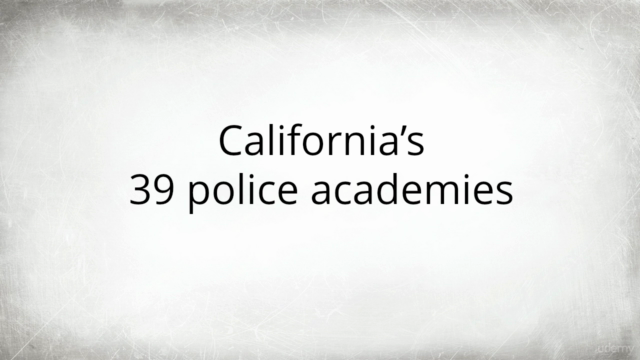StudiGuide 37: People with Disabilities

Why take this course?
🚔 StudiGuide 37: People with Disabilities 🎓
Welcome to the StudiGuide 37 course, designed specifically for police academy cadets preparing for the California Police Academy (P.O.S.T.) Written Examination. This comprehensive study guide will equip you with the necessary knowledge and practice to understand and excel in the POST examinations, focusing on interactions with people who have disabilities.
Key Topics Covered:
📘 Understanding Disabilities:
-
Differentiate between actions for peace officers when dealing with individuals with mental illness, including those who are a danger to others, a danger to self, gravely disabled, or not dangerous/gravely disabled.
-
Define the terms 'mental illness' and 'developmental disability'.
-
List the types of mobility assistance equipment and devices available, as well as the categories of mental illness (e.g., Thought disorders like schizophrenia and Mood disorders like depression and bipolar).
-
Identify methods officers can use to communicate effectively with individuals who are deaf or hard of hearing.
-
Recognize the role of peace officers when interacting with individuals with disabilities, behavioral indicators associated with developmental disabilities, and appropriate actions during field contacts.
-
State the intent of key legislation such as the Americans with Disabilities Act (ADA) and the Lanterman-Petris-Short (LPS) Developmental Disabilities Service Act.
-
Explain the resources available to individuals with disabilities at both state and local levels, and the specifics of the LPS Act.
-
Discuss various neurological disorders, including Acquired and Traumatic Brain Injuries, and additional laws that protect the rights of people with physical disabilities, such as the Rehabilitation Act of 1973 (Section 504), Right of Way (Vehicle Code Section 21963), White Cane Law (Civil Code Section 54.4), and Service Animals (Penal Code Section 365.5 et seq.).
Why This Matters:
As a peace officer, understanding how to appropriately interact with individuals who have disabilities is crucial. It not only ensures the safety of the officer and the community but also respects the rights of those with disabilities. This guide will help you navigate the nuances of these interactions confidently and professionally.
What You Will Learn:
-
Behavioral Indicators: Recognize signs that may indicate a person is affected by mental illness or has a developmental disability, such as Mental retardation, Cerebral Palsy, Autism, Epilepsy, Blindness, or Deafness.
-
Appropriate Actions: Understand the correct tactics and communication methods to employ during field contacts with individuals who are visually impaired, deaf or hard of hearing, or affected by mental illness.
-
Determination of Danger: Learn how to assess if a person with a mental illness is a danger to others or to themselves and the appropriate actions to take under the Welfare and Institutions Code section 5150.
-
Legal Knowledge: Gain insight into the laws that protect the rights of individuals with disabilities, ensuring you are prepared to serve and protect within these guidelines.
Prepare for Success:
This StudiGuide is not just a reference—it's your pathway to success on the POST exam. By mastering the material presented here, you will be well-equipped to demonstrate your understanding in the End-of-Course Proficiency Test. Remember, knowledge of these interactions is vital for the safety of all parties involved and for upholding the law with integrity.
Your Next Steps:
Study each topic carefully, engage with the material actively, and apply the principles you learn in real-world scenarios. With dedication and focus, you will not only pass the exam but also become a more effective and compassionate peace officer. Let's embark on this journey together towards a deeper understanding of how to serve our communities inclusively and respectfully. 👮♂️✨
Selected information from this written examination will be integral to your success on the End-of-Course Proficiency Test, so let's get started!
Course Gallery




Loading charts...